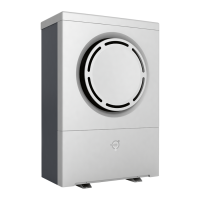4 Piping installation
Caution Piping installation must be carried out in accordance with applicable local rules and regulations. The hot wa-
ter tank must be equipped with an approved safety valve.
Caution To prevent leaks, ensure that there are no stresses in the connecting pipes!
Caution It is important that the heating system is bled after installation. Bleed valves must be installed where necessa-
ry.
Caution There is a risk of the pipes to the heat pump freezing when water circulation through the heat pump stops
when outdoor temperatures fall below freezing. Normally the integrated flow sensor gives an alarm if there is
low flow (assumes that there is current to the heat pump), for example when the radiator pump has stopped.
In the event of longer flow stops, for example in case of power failure or if the plant is OFF, there is however
an obvious risk of freezing . By installing a stop cock on the inside of the house wall it is possible to drain the
part of the system that goes out to the heat pump if necessary.
Another way of ensuring against freezing is to install an intermediate exchanger indoors. In such cases one
must use glycol intended for refrigerant applications in the circuit to the heat pump unit and an extra circula-
tion pump, see System solution intermediate exchanger. Another option is to fill the heating system with anti-
freeze.
Caution Heating systems with closed expansion tanks must also be supplied with approved pressure gauges and safe-
ty valves.
Caution Cold and hot water pipes and overflow pipes from safety valves must be made of heat resistant and corro-
sion-resistant material, e.g. copper. The safety valve overflow pipes must have an open connection to the
drain and visibly flow into this in a frost-free environment.
Caution The connecting pipe between the expansion tank and the safety valve must slope continuously upwards. A
continuous upwards slope means that the pipe must not slope downwards from the horizontal at any point.
Configure the heat pump for the desired system solution in the SERVICE\ADD. HEATER\EXTERNAL ADDITION
menu.
4.1 Water volume in heating system
In order to secure the defrosting of the outdoor unit, a minimum amount of water must be contained in the heating system. This is
shown in the table below.
If the heating system itself holds the amount of water described in the table, a volume tank is not needed, but recommended.

